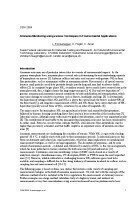Air Monitoring
Ammonia Monitoring using various Techniques in Environmental Applications
Oct 03 2014
Author: L. Emmenegger, C. Hüglin, K. Zeyer on behalf of CEM
Introduction
Ammonia emissions are of particular interest due to a variety of environmental impacts. As the primary atmospheric base, ammonia plays a crucial role in determining the acid-neutralizing capacity of tropospheric air masses [1]. Airborne sulfuric and nitric acid can react with gaseous NH3 to form fine particulates, such as ammonium sulfate or ammonium nitrate. Fine aerosol is of special concern because small particles are able to penetrate deeply into the lung and may lead to adverse health effects [2]. As compared to gas-phase NH3, secondary aerosols have a much slower removal rate in the atmosphere and, thus, a higher chance for long-range transport [3, 4]. Dry and wet deposition of gaseous ammonia and ammonium aerosol contributes to both acidification and eutrophication, which may cause damage to sensitive ecosystems such as forests, heathlands and bogs [3]. In Switzerland, the deposition of nitrogen (from NOx and NH3) is above the critical loads for forests in about 90% of the forest land [5], and long-term measurements of NO2 and NH3 fluxes have shown that rates of NH3 deposition typically exceed those of NO2, sometimes by an order of magnitude [6].
The major sources for atmospheric NH3 are agricultural activities and animal feedlot operations, followed by biomass burning (including forest fires) and to a lesser extent fossil fuel combustion [7]. Industrial sources, although minor with respect to global considerations, may be very important locally [8]. The contribution of road traffic to the non-agricultural ammonia emissions has been considered to be rather small. However, recent studies indicate that NH3 emission rates from automobiles may be higher than previously estimated, and that traffic might be an important source of ammonia in urban areas [9].
Ammonia measurements are challenging for a number of reasons. While NH3 is a gas with a boiling point of -33.4 °C, it readily reacts with acids to form ammonium aerosols. In industrial processes this form can dominate and behave like small particulates, which has large implications on sampling and measurement strategies, as well as on legal regulations. The absorption of ammonia - and to some extend of ammonium aerosols - in diluted acid, followed by analysis of NH4 + is the classical approach, which has been published in various countries for both emission [10] and ambient air [11] measurements. Continuous emission monitoring systems (CEMS) can be based on a variety of analytical concepts: chemiluminescence, UV-absorption, NDIR, or FTIR to name the most important ones [12]. However, reliable calibration is challenging because NH3 reference gases tend to be unstable, and sampling is difficult due to the strong tendency of ammonia to adsorb to surfaces such as sampling line and measurement cell [13-15].
The following paper is based on three case studies that include a wide variety of sampling and measurement strategies in the field of ammonia measurements. We will start with the concepts of the reference method which is included in the Swiss regulations for measurements at stationary sources. Further examples are a large method validation study at a highway tunnel, and ambient air measurements at very low concentratinos using a novel instrument based on photoaccoustic laser spectroscopy. The last example also illustrates how excellent ambient air measurement data might be used to validate and complement classical emission data.
Digital Edition
AET 28.2 April/May 2024
May 2024
Business News - Teledyne Marine expands with the acquisition of Valeport - Signal partners with gas analysis experts in Korea Air Monitoring - Continuous Fine Particulate Emission Monitor...
View all digital editions
Events
Jul 30 2024 Jakarta, Indonesia
China Energy Summit & Exhibition
Jul 31 2024 Beijing, China
2024 Beijing International Coal & Mining Exhibition
Aug 07 2024 Beijing, China
IWA World Water Congress & Exhibition
Aug 11 2024 Toronto, Canada
Aug 25 2024 Stockholm, Sweden and online






.jpg)








